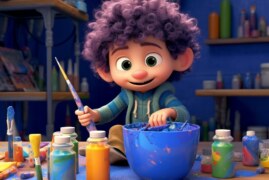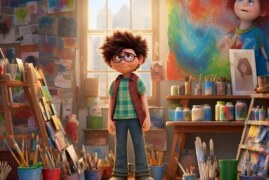Orange is a warm and vibrant color that adds a bold touch to any art project, whether it is painting, textiles, or graphic design. But have you ever wondered how to make the color orange? Maybe you are a beginner artist, or you want to experiment with unique shades to add more depth to your artwork. Regardless of your experience level, learning how to mix and create the perfect shade of orange is a fundamental skill in the world of art and design. In this article, we will guide you through the process of making the color orange with different techniques, mediums, and color theory principles. So grab your paintbrushes or pens and let’s dive into the world of orange hues!
1. Understanding the Color Orange: The Basics of Color Theory
Color theory is a fundamental aspect of art and design that helps promote understanding of how certain colors work together to convey different meanings and evoke certain emotions. As such, it’s essential to understand what the color orange is, how it’s formed, and how it’s commonly used in art and design.
Orange is a secondary color that is created by mixing equal parts of red and yellow primary colors. It is often associated with warmth, energy, happiness, and vibrancy. It can also signify caution, danger, and traffic warning, as seen in orange traffic cones and hazard signs.
The color orange is prevalent in nature, including sunsets, citrus fruits, autumn leaves, pumpkins, and flowers. It’s often used to arouse feelings of enthusiasm, excitement, and fun in art and design, making it a trendy color choice for design projects such as logos, product packaging, and branding.
In summary, the color orange is created by mixing red and yellow primary colors, representing warmth, energy, and vibrancy. It’s often used to convey positive emotions and can be seen in nature and design projects. Developing an understanding of color theory, including the color orange, can help you create aesthetic and meaningful designs.
2. Mixing Pigments: Creating Different Shades of Orange
How to Make The Color Orange: Mixing Pigments
Mixing pigments is an effective way of creating different hues and shades of orange. In this section, we’ll explore some techniques on how to achieve this with ease.
The Basics of Pigment Mixing
To begin with, it’s important to understand that the color wheel plays a significant role in pigment mixing. Orange is a secondary color that is created by combining red and yellow, which are primary colors. The amount of each primary color used will determine the shade of orange you get. For example, adding more yellow to the mix will result in a yellowish-orange color, while adding more red will create a reddish-orange hue.
Pigment Combinations to Create Orange Shades
There are different combinations you can use to create unique shades of orange. Here are a few examples:
- Yellow ocher + cadmium red = bright orange
- Cadmium yellow + Alizarin crimson = rich orange-brown
- Orange lake + Gamboge yellow = vibrant orange
It’s important to note that the type of pigments used also affects the shades of orange achieved. For instance, some pigments are more opaque, while others are more transparent. Therefore, understanding the properties of the pigments used can help achieve a desired effect.
Creating Tertiary Colors
Tertiary colors are created by mixing a primary color with a secondary color. To create a tertiary color with orange, you can combine it with a shade of green or purple. For instance, mixing ultramarine blue with cadmium red and cadmium yellow will result in a burnt orange hue.
In conclusion, mixing pigments is a fun and creative way of creating unique shades of orange. By understanding the basics of color theory and the role of primary colors, as well as experimenting with different combinations of pigments, anyone can mix their way to the perfect shade of orange.
3. The Science of Color Mixing: The Role of Primary Colors
Understanding the science of color mixing is essential in creating the color orange effectively. The first step in this process is to understand and identify primary colors. Primary colors are the three pigments that cannot be created by mixing other colors. The primary colors are red, yellow, and blue.
By combining equal amounts of red and yellow pigments, the result is an orange hue. This is because orange is a secondary color, formed by mixing two primary colors. In color theory, secondary colors are created by mixing two primary colors in equal proportions.
It is important to note that the hue and intensity of the resulting orange shade depend on the ratio of the pigments used for mixing. For example, adding more red pigment to yellow will result in a darker orange hue, while adding more yellow will produce a lighter shade.
In addition to the primary colors, there are also tertiary colors formed by mixing a primary and secondary color. This process allows for even more variation in shade and hue, making color mixing a science that requires experimentation and practice. Understanding the science and theory behind color mixing can help artists and designers create harmonious and impactful designs with the color orange.
4. Using Color Combinations: Creating Harmonious Designs with Orange
When it comes to incorporating the color orange in your art and designs, knowing which colors to pair it with is key to creating a harmonious and visually appealing composition. Keep in mind that orange is a warm and vibrant color that can evoke feelings of energy, enthusiasm, and creativity. Here are some color combinations that work well with orange:
Orange and Yellow:
Combining orange and yellow can create a vibrant and cheerful color scheme that’s perfect for a summer-inspired art or design project. This combination can also be used to create a gradient effect, where the colors transition smoothly from one hue to another.
Orange and Blue:
Pairing orange with a cooler tone like blue can create a striking contrast that’s perfect for high-impact designs. This color combination works well in branding projects or in creating visuals that need to convey a sense of excitement or urgency.
Orange and Green:
Combining orange with green can create a color scheme that’s fresh and invigorating, and works well for nature-inspired designs. Use this combination to evoke feelings of growth, harmony, and balance.
Tip: Don’t be afraid to experiment with different shades and tones of orange, as well as with different color combinations. Be mindful of the mood and message you want to convey through your art or design, and adjust your color choices accordingly. Remember to also consider the color psychology of your chosen colors, as certain hues can elicit different emotions and associations in viewers.
5. Incorporating Orange in Art and Design: Tips and Tricks for Effective Use
Orange is a versatile color that can add warmth, energy, and vibrancy to any art or design project. Whether you’re creating a logo, painting, or graphic design, incorporating orange can help you create a striking and memorable visual. Here are some tips and tricks for effectively using orange in your art and design projects:
1. Pair Orange with Complementary Colors
Orange is a secondary color made by mixing red and yellow. Its complementary color is blue, which means that using blue and orange together can create a bold and visually appealing contrast. Using a color wheel can help you identify complementary colors and create a harmonious color palette.
2. Use Orange as an Accent Color
Orange can be overwhelming if used excessively, but it can also add a pop of color and excitement when used as an accent. Consider using orange sparingly in your design, such as in a logo, button, or subtitle. This will draw the viewer’s attention and create a focal point.
3. Experiment with Different Shades of Orange
Mixing different amounts of red and yellow can create a range of orange shades, from neon to earthy. Experimenting with different shades can help you create different moods and tones in your artwork or design. Darker oranges can create a cozy and warm feeling, while brighter oranges can convey energy and excitement.
Using these tips and tricks, you can effectively incorporate orange into your art and design projects. Remember to experiment and have fun with color to create visually appealing and memorable designs.
People Also Ask
1. How do you make the color orange with primary colors?
To make orange with primary colors, mix equal parts of red and yellow. The 3 primary colors are red, blue, and yellow. When you mix two of these colors, you can create secondary colors such as green, purple or orange.
2. How do you make the color orange with food coloring?
To create orange with food coloring, mix equal parts of red and yellow food coloring. You can also adjust the amount of each color to make the shade of orange you want.
3. Can you mix purple and orange to make brown?
No, you cannot mix purple and orange to make brown. Brown is a tertiary color and can only be made by mixing a primary color with a secondary color. To make brown, mix equal parts of red, blue and yellow.
4. How do you make the color burnt orange?
To make burnt orange, mix red, yellow, and brown paint in a 2:2:1 ratio. Burnt orange is a darker shade of orange and has a brownish-red hue.
5. How do you make orange with paint?
To make orange with paint, mix red and yellow paint in equal parts. You can also adjust the amount of each color to create different shades of orange, ranging from light peach to dark rust.
Conclusion
In conclusion, making the color orange is easy with the right proportions of red and yellow. You can create different shades of orange by adjusting the proportion of these two colors, whether you are mixing paint or food coloring. Additionally, burnt orange is a darker shade of orange created through adding brown paint to the mix. Remember that you cannot create brown when mixing purple and orange, as brown is a tertiary color.



